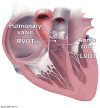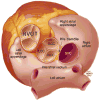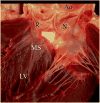The anatomic basis for ventricular arrhythmia in the normal heart: what the student of anatomy needs to know
- PMID: 24446306
- PMCID: PMC4477267
- DOI: 10.1002/ca.22362
The anatomic basis for ventricular arrhythmia in the normal heart: what the student of anatomy needs to know
Abstract
The traditional route for teaching cardiac anatomy involves didactic instruction, cadaver dissections, and familiarization with the main structure and relationships of the cardiac chambers, valves, and vasculature. In contemporary cardiac electrophysiology, however, a very different view of anatomy is required including details rarely appreciated with a general overview. In this review, we discuss the critical advances in cardiac electrophysiology that were possible only because of understanding detailed anatomic relationships. While we briefly discuss the clinical relevance, we explain in depth the necessary structural information for the student of clinical anatomy. Interspersed through the text are boxes that highlight and summarize the critical pieces of knowledge to be borne in mind while studying the fascinating structural anatomy of the human heart.
Keywords: cardiac anatomy; catheter ablation; complications; outflow tract; ventricular tachycardia.
© 2014 Wiley Periodicals, Inc.
Conflict of interest statement
Conflicts of Interest: None
Figures











Similar articles
-
Anatomical relevance of ablation to the pulmonary artery root: Clinical implications for characterizing the pulmonary sinus of Valsalva and coronary artery.J Cardiovasc Electrophysiol. 2018 Sep;29(9):1230-1237. doi: 10.1111/jce.13685. Epub 2018 Aug 9. J Cardiovasc Electrophysiol. 2018. PMID: 29978934
-
Anatomy of the Ventricular Outflow Tracts: An Electrophysiology Perspective.Clin Anat. 2024 Jan;37(1):43-53. doi: 10.1002/ca.24083. Epub 2023 Jun 19. Clin Anat. 2024. PMID: 37337379 Review.
-
Left sinus of Valsalva-Electroanatomic basis and outcomes with ablation for outflow tract arrhythmias.J Cardiovasc Electrophysiol. 2020 Apr;31(4):952-959. doi: 10.1111/jce.14388. Epub 2020 Feb 18. J Cardiovasc Electrophysiol. 2020. PMID: 32048387
-
Anatomy of the left main coronary artery of particular relevance to ablation of left atrial and outflow tract arrhythmias.Heart Rhythm. 2014 Dec;11(12):2231-8. doi: 10.1016/j.hrthm.2014.08.006. Epub 2014 Aug 9. Heart Rhythm. 2014. PMID: 25111323
-
Catheter ablation of tachyarrhythmias from the aortic sinuses of Valsalva--when and how?Circ J. 2012;76(4):791-800. doi: 10.1253/circj.cj-11-1554. Circ J. 2012. PMID: 22451447 Review.
Cited by
-
Mechanism, diagnosis, and treatment of outflow tract tachycardia.Nat Rev Cardiol. 2015 Oct;12(10):597-608. doi: 10.1038/nrcardio.2015.121. Epub 2015 Aug 18. Nat Rev Cardiol. 2015. PMID: 26283265 Review.
-
Idiopathic Ventricular Tachycardia.J Clin Med. 2023 Jan 25;12(3):930. doi: 10.3390/jcm12030930. J Clin Med. 2023. PMID: 36769578 Free PMC article. Review.
-
2019 HRS/EHRA/APHRS/LAHRS expert consensus statement on catheter ablation of ventricular arrhythmias.Europace. 2019 Aug 1;21(8):1143-1144. doi: 10.1093/europace/euz132. Europace. 2019. PMID: 31075787 Free PMC article.
-
2019 HRS/EHRA/APHRS/LAHRS expert consensus statement on catheter ablation of ventricular arrhythmias.J Interv Card Electrophysiol. 2020 Oct;59(1):145-298. doi: 10.1007/s10840-019-00663-3. J Interv Card Electrophysiol. 2020. PMID: 31984466 Free PMC article.
-
Improved Reversion of Calcifications in Porcine Aortic Heart Valves Using Elastin-Targeted Nanoparticles.Int J Mol Sci. 2023 Nov 17;24(22):16471. doi: 10.3390/ijms242216471. Int J Mol Sci. 2023. PMID: 38003660 Free PMC article.
References
-
- Abouezzeddine O, Suleiman M, Buescher T, Kapa S, Friedman PA, Jahangir A, Mears JA, Ladewig DJ, Munger TM, Hammill SC, Packer DL, Asirvatham SJ. Relevance of endocavitary structures in ablation procedures for ventricular tachycardia. J Cardiovasc Electrophysiol. 2010;21:245–254. - PubMed
-
- Aiba T, Suyama K, Aihara N, Taguchi A, Shimizu W, Kurita T, Kamakura S. The role of Purkinje and pre-Purkinje potentials in the reentrant circuit of verapamil-sensitive idiopathic LV tachycardia. Pacing Clin Electrophysiol. 2001;24:333–344. - PubMed
-
- Ainge G, Clarke CJ. Spontaneous myocardial concentration of Purkinje fiberlike cells in a Beagle dog. Toxicol Pathol. 2000;28:827–828. - PubMed
-
- Airey JA, Almeida-Porada G, Colletti EJ, Porada CD, Chamberlain J, Movsesian M, Sutko JL, Zanjani ED. Human mesenchymal stem cells form Purkinje fibers in fetal sheep heart. Circulation. 2004;109:1401–1407. - PubMed
-
- Aizawa Y, Naitoh N, Kitazawa H, Kusano Y, Uchiyama H, Washizuka T, Shibata A. Frequency of presumed reentry with an excitable gap in sustained ventricular tachycardia unassociated with coronary artery disease. Am J Cardiol. 1993;72:916–921. - PubMed
Publication types
MeSH terms
Grants and funding
LinkOut - more resources
Full Text Sources
Other Literature Sources
Medical

